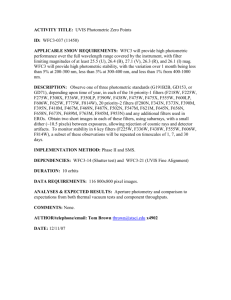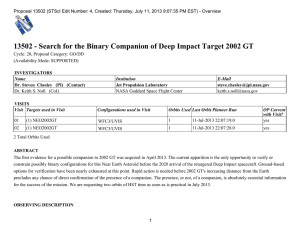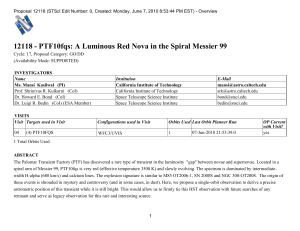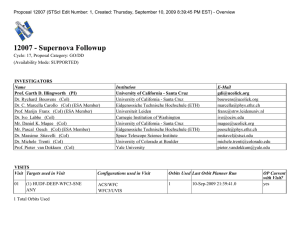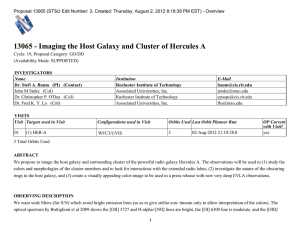14501 - Confirming the wide binary companion of IRC+10216
advertisement
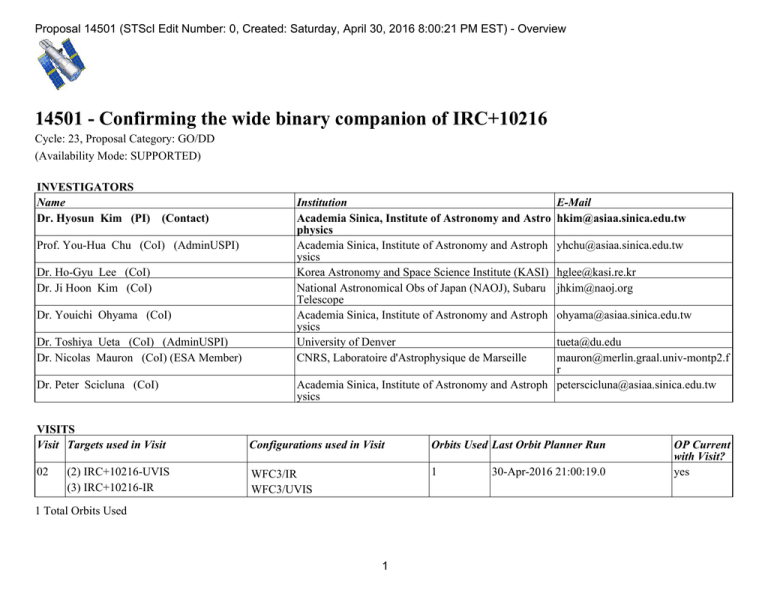
Proposal 14501 (STScI Edit Number: 0, Created: Saturday, April 30, 2016 8:00:21 PM EST) - Overview 14501 - Confirming the wide binary companion of IRC+10216 Cycle: 23, Proposal Category: GO/DD (Availability Mode: SUPPORTED) INVESTIGATORS Name Dr. Hyosun Kim (PI) (Contact) Prof. You-Hua Chu (CoI) (AdminUSPI) Dr. Ho-Gyu Lee (CoI) Dr. Ji Hoon Kim (CoI) Dr. Youichi Ohyama (CoI) Dr. Toshiya Ueta (CoI) (AdminUSPI) Dr. Nicolas Mauron (CoI) (ESA Member) Dr. Peter Scicluna (CoI) VISITS Visit Targets used in Visit 02 (2) IRC+10216-UVIS (3) IRC+10216-IR Institution Academia Sinica, Institute of Astronomy and Astro physics Academia Sinica, Institute of Astronomy and Astroph ysics Korea Astronomy and Space Science Institute (KASI) National Astronomical Obs of Japan (NAOJ), Subaru Telescope Academia Sinica, Institute of Astronomy and Astroph ysics University of Denver CNRS, Laboratoire d'Astrophysique de Marseille E-Mail hkim@asiaa.sinica.edu.tw yhchu@asiaa.sinica.edu.tw hglee@kasi.re.kr jhkim@naoj.org ohyama@asiaa.sinica.edu.tw tueta@du.edu mauron@merlin.graal.univ-montp2.f r Academia Sinica, Institute of Astronomy and Astroph peterscicluna@asiaa.sinica.edu.tw ysics Configurations used in Visit Orbits Used Last Orbit Planner Run WFC3/IR WFC3/UVIS 1 1 Total Orbits Used 1 30-Apr-2016 21:00:19.0 OP Current with Visit? yes Proposal 14501 (STScI Edit Number: 0, Created: Saturday, April 30, 2016 8:00:21 PM EST) - Overview ABSTRACT The latest HST optical images of the nearest carbon-rich asymptotic giant branch (AGB) star IRC+10216 revealed two point-like sources at the center of its circumstellar envelope (CSE). A plausible interpretation is that the dense inner envelope is clearing, and hence revealing the central binary stars and the associated structures. Since IRC+10216 has changed so dramatically in 10 years, more frequent monitoring is necessary. A similar dramatic change is also found in the near-infrared (NIR). The clumps detected over two decades have disappeared in a ground-based observation in Feb. 2016, leaving a single peak in H and K and two peaks in J. The second peak in J has a different color from that of the primary peak and its CSE, implying a different origin and thus supporting the identification as a companion star. In particular, its spectral peak is likely at a wavelength slightly shorter than J band, consistent with an M-type main-sequence star. However, its correspondance with the optical source is not conclusive because of the small field of view of the ground-based NIR observations, traded with the high resolution using the adaptive optics. In order to confirm/refute the identication of the AGB star IRC+10216 and its companion and to monitor the evolution of its CSE, we propose for WFC3 snapshots in two UVIS bands and one IR band to simultaneously achieve (1) high resolution and (2) large field of view for astrometry. This would be the first confirmation of a "main-sequence companion" consisting a "wide binary" with an AGB star, which is the major category of missing companions of evolved stars. This observation is optimized near the light curve minimum, which is now. OBSERVING DESCRIPTION The proposed observations are to take WFC3 images of IRC+10216 in two UVIS bands (F606W and F814W) and one IR band (F098M). The F606W and F814W observations are the repeats of the previous PID 12205 observations (June 4, 2011) but for shorter integration times. It will also be observed with the F098M filter, which will bridge the F606W and F814W images to our newly observed GEMINI/NIFS data in J band. The 2011 HST F606W and F814W images consist of one bright point-like source (tentatively identified as a carbon star; IRC+10216 A) connected by bright North-South blobs with a ~0.4 arcsec extension and one weaker point-like source (tentatively identified as a companion, M-type mainsequence star; IRC+10216 B) at ~0.5 arcsec east of the bright source. There were several diffuse clumps surrounding these point-like sources. See Figure 1(c) in the proposal pdf file. As the nature of a carbon star, it has an extended component with FWHM > 1 arcsec over ~100 arcsec (Figure 1(e)). The carbon star (and thus the extended halo component) light is currently in the increasing phase (see Figure 2, dark gray), and the F098M observation would enter nonlinear (or saturation) regime after May 5-10. EARLIER EXECUTION IS DESIRED, and a careful treatment is required after this date. IRC+10216 is not visible in the HST orbit after June 24. With the on-source time ~700 sec, ~60 sec, and ~15 sec for F606W, F814W, and F098M, the companion (0.3-0.5 arcsec east of the peak) would have 2 Proposal 14501 (STScI Edit Number: 0, Created: Saturday, April 30, 2016 8:00:21 PM EST) - Overview S/N>100. We do not expect any saturation issue for the two UVIS bands. The IR band (F098M) could have saturation issue, therefore we will set the individual exposure time to be the minimum (~2.9 sec). We expect the peak pixel of F098M image to remain in a linear regime before ~May 5 (no later than May 10) and to enter non-linear regime but not to be saturated before ~June 24. The observations with all 3 filters will be completed in one orbit. To bridge the gap between the UVIS chips for F606W and F814W, we will use a 2point dither following the WFC3-UVIS-GAP-LINE pattern. For the NIR imaging, we will use a 2-point dither applying the WFC3-IR-DITHERBLOB pattern to mitigate the effects of blobs and other artifacts. 3 Proposal 14501, Visit 02, implementation Diagnostic Status: No Diagnostics Scientific Instruments: WFC3/IR, WFC3/UVIS Special Requirements: (none) # Primary Pattern Secondary Pattern (1) Pattern Type=WFC3-UVIS-GAP-LINE Coordinate Frame=POS-TARG Purpose=MOSAIC Pattern Orientation=85.759 Number Of Points=2 Angle Between Sides= Point Spacing=2.414 Center Pattern=true Line Spacing= (2) Pattern Type=WFC3-IR-DITHERCoordinate Frame=POS-TARG BLOB Pattern Orientation=41.859 Purpose=DITHER Angle Between Sides= Number Of Points=2 Center Pattern=true Point Spacing=5.183 Line Spacing= # Name Target Coordinates Targ. Coord. Corrections (2) IRC+10216-UVIS RA: 09 47 59.5193 (146.9979971d) Dec: +13 16 59.12 (13.28309d) Equinox: J2000 (3) IRC+10216-IR RA: 09 47 59.6487 (146.9985363d) Dec: +13 16 47.42 (13.27984d) Equinox: J2000 # Label Target Config,Mode,Aperture Spectral Els. Opt. Params. 1 (3) IRC+10216-IR WFC3/IR, MULTIACCUM, IR F098M NSAMP=1; SAMP-SEQ=RAPI D Exposures Fixed Targets Patterns Visit Proposal 14501 - Visit 02 - Confirming the wide binary companion of IRC+10216 2 3 (2) IRC+10216-UVI WFC3/UVIS, ACCUM, UVIS S (2) IRC+10216-UVI WFC3/UVIS, ACCUM, UVIS S F606W F814W FLASH=4 4 Sun May 01 01:00:21 GMT 2016 Exposures (2), (3) (1) Special Reqs. Fluxes V=10.96 Miscellaneous Reference Frame: SIMBAD V=10.96 Reference Frame: SIMBAD Groups Exp. Time (Total)/[Actual Dur.] Pattern 2, Exps 1-1 i 2.932291 Secs X 6 (35.187 Secs) n Visit 02 (2) [==>(Pattern 1, Copy 1)] [==>(Pattern 1, Copy 2)] [==>(Pattern 1, Copy 3)] [==>(Pattern 1, Copy 4)] [==>(Pattern 1, Copy 5)] [==>(Pattern 1, Copy 6)] [==>(Pattern 2, Copy 1)] [==>(Pattern 2, Copy 2)] [==>(Pattern 2, Copy 3)] [==>(Pattern 2, Copy 4)] [==>(Pattern 2, Copy 5)] [==>(Pattern 2, Copy 6)] Pattern 1, Exps 2-2 i 350 Secs (700 Secs) n Visit 02 (1) [==>(Pattern 1)] [==>(Pattern 2)] Pattern 1, Exps 3-3 i 350 Secs (700 Secs) n Visit 02 (1) [==>(Pattern 1)] [==>(Pattern 2)] Orbit [1] [1] [1] Orbit Structure Proposal 14501 - Visit 02 - Confirming the wide binary companion of IRC+10216 5
